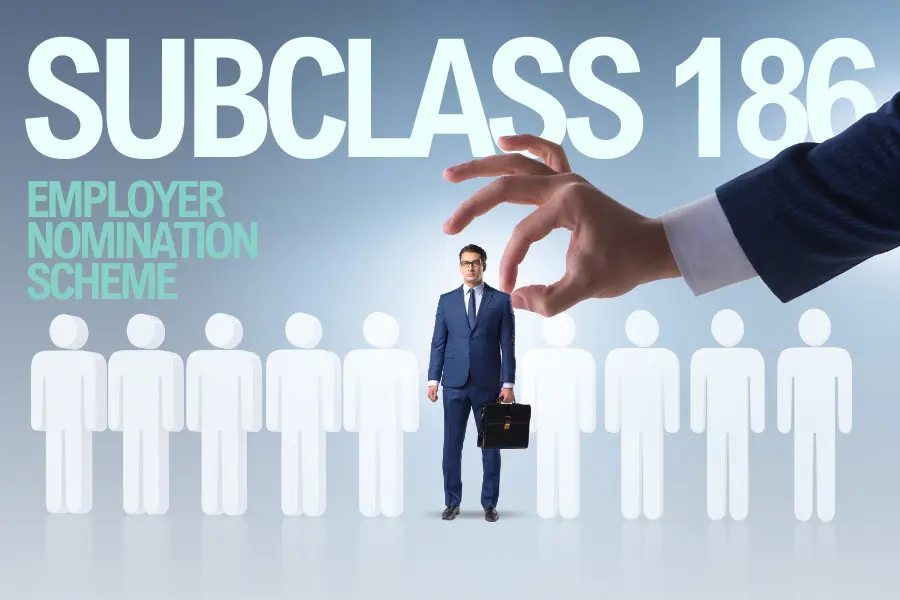If you are currently in Australia on a temporary skilled visa and are aiming for a secure route to permanent residency, the Employer Nomination Scheme visa, known as the Subclass 186, is one of the most reliable options available. In 2025 and 2026, it remains one of the strongest employer-backed pathways to permanent residency, especially for those holding Subclass 482 or legacy Subclass 457 visas.
How the Subclass 186 Visa Works
The Subclass 186 visa is a permanent residency visa that requires both employer and applicant participation. The process begins with your employer lodging a nomination for a genuine full-time role that offers market rate pay. Once that nomination is submitted, you then lodge your visa application, which must demonstrate that you meet the requirements relating to age, English proficiency, health, character, and skills. The processing time is guided by the Department of Home Affairs and often depends on whether your application is complete and decision ready at the time of lodgement.
Understanding the Three Streams
There are three main streams under the Subclass 186 visa.
The Direct Entry (DE) stream is suitable for applicants who are eligible to move directly to permanent residency without first spending years in Australia on a temporary sponsorship. To qualify, your occupation must be on the relevant skilled occupation list, and most applicants will need a positive skills assessment and relevant work experience. You must also demonstrate at least Competent English, either by taking an approved test or holding an eligible passport.
The Temporary Residence Transition (TRT) stream is the most common pathway for people who are already working in Australia for their sponsoring employer under a Subclass 482, a legacy 457, or an eligible bridging visa. Generally, you must have completed at least two years of sponsored employment before your nomination and visa are lodged. A key advantage of the TRT stream is that it does not rely on the current occupation lists, which means your pathway is less affected by policy changes that may alter which roles are eligible.
The Labour Agreement (LA) stream applies when your employer is part of a Labour Agreement, which could be an industry agreement, a company-specific agreement, or a Designated Area Migration Agreement (DAMA). This stream follows the conditions of the agreement and may provide concessions in relation to English requirements, skills, or age. To be eligible, you must be employed, or preparing to work, for the employer who is party to the agreement.
Who Benefits Most in 2025–2026
For many professionals on a Subclass 482 visa, the TRT stream is the most straightforward pathway. By continuing to work in your sponsored occupation and completing the two-year requirement with your employer, you can be nominated for permanent residency. Because this stream is not tied to occupation lists, it is often considered more stable than Direct Entry for roles that move on and off those lists.
Applicants who are offshore or onshore without recent 482 or 457 employment may find that the Direct Entry stream provides a quicker option. If your occupation is on the eligible list and you can obtain a positive skills assessment, Direct Entry can take you to permanent residency without waiting two years. For those covered by a Labour Agreement, the best approach is to follow the concessions and requirements within the agreement itself, which may provide more flexibility than standard rules.
English, Skills, and Occupation Requirements
The Department of Home Affairs sets English language thresholds for visa applicants. For the Subclass 186 visa, most applicants will need to demonstrate Competent English, unless they qualify for an exemption. The Direct Entry stream typically requires a skills assessment from the relevant authority, while the TRT stream focuses more on your recent sponsored employment history rather than requiring a new assessment. Eligibility under Direct Entry is defined by the Department’s occupation lists, so it is important to confirm your role is included before applying.
Salary and Nomination Conditions
Each employer nomination must demonstrate that the position is genuine, that the salary offered meets or exceeds market salary levels, and that the employment conditions align with Australian workplace standards. Employers also need to show that the business has a genuine need for the role and that the nominated position is consistent with the business’s operations.

Fees and Processing Times
The visa application charge for a primary Subclass 186 applicant begins at AUD 4,910. Additional charges apply for family members included in the application. Employers are responsible for paying a separate nomination fee along with the Skilling Australians Fund levy. The levy is an employer expense and cannot be passed on to the applicant. Processing times vary across the different streams and depend on factors such as caseloads and whether the application is complete at lodgement. Applications that include all required documents, such as health and character clearances, English evidence, and skills assessments, tend to be processed more smoothly.
What This Means for Subclass 482 and 457 Holders
If you are currently employed in Australia in the same occupation as your most recent temporary skilled visa, your employer can usually nominate you for the TRT stream once you have completed the two-year requirement of sponsored work. Since this pathway does not rely on occupation lists, it is generally less vulnerable to policy changes. If you have changed employers during your time on a temporary visa, it is important to carefully review your employment history to confirm whether your time counts toward eligibility and whether any gaps might impact your case.
How NB Migration Law Can Help
At NB Migration Law, we begin by mapping the fastest and most compliant stream for your individual situation, taking into account your current visa, occupation, and time spent under sponsorship. For Direct Entry applicants, we coordinate your skills assessment, confirm English requirements, and collect supporting evidence so that your application is ready for decision. For TRT applicants, we conduct a detailed review of payroll records, contracts, and position descriptions to verify that the two-year employment condition is satisfied and that the nomination meets salary and genuineness tests. Where a Labour Agreement is involved, we interpret the concessions and ensure your documents align with the agreement. We also keep track of processing time updates and respond quickly to any requests for further information to help keep your case moving forward.

